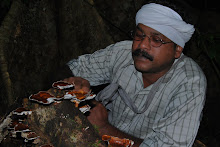Pit Vipers are a group of snakes belonging to the subfamily crotalinae. The Asian pit vipers are characterized by a stout body, a short prehensile tail and a broad sub triangular head with specialized heat sensing pits between the eye and the nostrils. They are venomous with specialized movable front fangs. Most of them are ovo-viviparous giving birth to live young.
The unique habitats of the Western Ghats is home to 6 species of pit vipers of which 4 are endemic to the Western Ghats and is found nowhere else in the world. Like all pit vipers they are venomous but their venom is not as toxic as other Indian venomous snakes and has resulted in very few fatalities. Their venom is adapted mainly to kill prey such as frogs, lizards, birds & rodents. The pit vipers of Western ghats belong to 4 genus which are


Trimeresurus: These are a group of stout snakes with a broad triangular head with small scales. The scales may be slightly keeled. They are mostly arboreal but can also be found on rocks. They are mainly found close to streams. They include 3 species in the Western Ghats.
- Malabar Pit Viper (Trimeresurus malabaricus)
- Bamboo Pit Viper (Trimeresurus gramineus)
- Horseshoe Pit Viper (Trimeresurus strigatus)

Peltopelor: This is a monotypic genus containing only a single species. They are charecterised by their triangular head covered by large scales. They have a prehensile tail adapted for its arboreal habit. They can also be found on rocks close to streams. The distribution of this snake is restricted to a few highly elevated localities of Tamilnadu and Kerala. As mentioned above, it includes only a single species
- Large-scaled Pit Viper (Peltopelor macrolepis)

Hypnale: The genus hypnale consists of small sized snakes with weakly keeled scales on the body. The head is broad, flat, and triangular and has large scales. The tip of the snout in these snakes is slightly upturned. They are mainly nocturnal and terrestrial inhabiting evergreen, moist and dry deciduous forests. This genus is distributed throughout the central and southern western ghats and Sri lanka. Only one species is know from the western ghats.
- Hump-nosed Pit Viper (Hypnale hypnale)
Tropidolaemus: This genus is charecterised by distinctly keeled small scales on the snout and head and strong keels on the gular region. This group consists of a single species in India which is known only from two specimens from the southern Western Ghats.
- Hutton’s Pit Viper (Tropidolaemu huttoni).
Though most of these snakes except the Huttons Pit Viper are common throughout the western ghats, They are found nowhere else in the world. In recent days habitat loss and habitat fragmentation in the western ghats has caused a major threat to their existence. Hence conservation of the western ghats should be a major priority.
 The Western Ghats or Sahyadri is a range of mountains that runs along the western coast of India. It stretches from the Satpur range in the north and ends in Kanyakumari in the southern tip of India. It is one of the 10 biodiversity hotspots with a high degree of endemic and endangered flora and fauna. This high endemism is due to its unique topography.
The Western Ghats or Sahyadri is a range of mountains that runs along the western coast of India. It stretches from the Satpur range in the north and ends in Kanyakumari in the southern tip of India. It is one of the 10 biodiversity hotspots with a high degree of endemic and endangered flora and fauna. This high endemism is due to its unique topography.





















